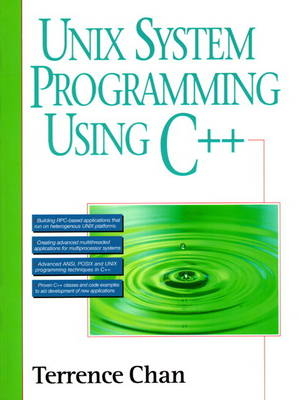
UNIX System Programming Using C++
Prentice Hall (Verlag)
978-0-13-331562-2 (ISBN)
- Titel ist leider vergriffen;
keine Neuauflage - Artikel merken
33156-1 Write more powerful C++ programs more quickly. If you're an experienced UNIX system programmer working in C++, UNIX System Programming Using C++ brings together all the advanced techniques you need to build more effective software. This book focuses on the real-life challenges you face developing network and client/server applications, databases, compilers, operating systems, and CAD systems. You'll learn new ways to develop C++ programs that are strongly type-checked, compact, and easy to maintain.You'll find in-depth coverage of: *Advanced ANSI C and C++ programming techniques, including function pointers and functions that accept variable numbers of arguments *How to use ANSI C library functions and C++ standard classes to reduce development time and maximize portability *The UNIX kernel structure and API -- and how to use them to manipulate system resources *UNIX processes and signals *UNIX sockets and TLI, the network transport protocols that allow you to create multi-tasking distributed client/server applications *UNIX multithreaded programming, including thread APIs, synchronization and thread-specific data The book includes extensive example programs that demonstrate how C++ classes, library functions and system APIs are used.
To help you build more portable applications, there's also coverage of the POSIX.1 and POSIX.1b standards. Today's distributed, networked applications require you to understand and utilize advanced UNIX system programming techniques. With UNIX System Programming Using C++, you won't just learn those techniques: you'll become comfortable using them.
1. Introduction. The applications of Advanced C and UNIX system calls. The history of UNIX. The ANSI-C and POSIX standards. Scope of book. 2. ANSI-C Language. ANSI-C language construct. Summary of differences between ANSI-C and K & R C. stdlib.h. limints.h. float.h. Template types. const. variables. Pointers and arrays. Function pointers. Object- oriented programming techniques with C. 3. Standard C Libraries. Data manipulation functions. Heap management functions. System query functions. 4. Standard I/O Libraries. stdio.h. and streams. Format I/O functions. Streams I/O. 5. Misc. C Library Functions. assert.h., setjmp., tdarg.h., gecopt., system, popen, pclose. 6. UNIX System Calls. System calls conventions. Portability issues of system calls. unistd.h. 7. UNIX File I/O Functions. Relationship of file descriptor and streams. fdopen, fileno. open, creat, umask, close. read, write, lseek. stat, fsat, lstat. chown, chmod, utime. link, symlink, readlink, unlink. dup, dup2, fcntl. File lockings. 8. UNIX Directories. Create directories: mknod and mkdir. Remove directories: rmdir. Directory traversal: dirent.h. ftw and nftw. 9. Special Files. Device files; mknod. Named pipes. 10. UNIX Processes Creation and Control. UNIX process structure. fork. exit. wait and waitpid. exec. pipe and I/O redirection. Amini-shell. 11. Signals. signals handling: signal, sigaction. signal masking. signal generation: kill, alarm. Interactions of signal and wait. 12. Interprocess Communication. Create client/server programs using IPC. System V IPC. Memory-mapped I/O: mmap. Sockets. TLI. Remote procedure calls. 13. Terminal Controls. ioctl. Curses package. 14. Future Directions of UNIX. Multi-thread processes. Object-oriented operating system. 15. Appendix A: Function Prototypes of C Library Functions and System Calls. Bibliography. Index.
| Erscheint lt. Verlag | 16.10.1996 |
|---|---|
| Verlagsort | Upper Saddle River |
| Sprache | englisch |
| Maße | 180 x 235 mm |
| Gewicht | 1168 g |
| Themenwelt | Informatik ► Betriebssysteme / Server ► Unix / Linux |
| Mathematik / Informatik ► Informatik ► Programmiersprachen / -werkzeuge | |
| Mathematik / Informatik ► Informatik ► Software Entwicklung | |
| ISBN-10 | 0-13-331562-2 / 0133315622 |
| ISBN-13 | 978-0-13-331562-2 / 9780133315622 |
| Zustand | Neuware |
| Informationen gemäß Produktsicherheitsverordnung (GPSR) | |
| Haben Sie eine Frage zum Produkt? |
aus dem Bereich


